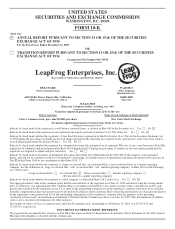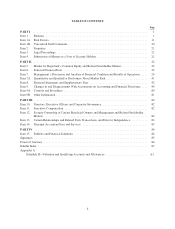LeapFrog 2009 Annual Report Download - page 16
Download and view the complete annual report
Please find page 16 of the 2009 LeapFrog annual report below. You can navigate through the pages in the report by either clicking on the pages listed below, or by using the keyword search tool below to find specific information within the annual report.Our products must also compete for leisure time of children and discretionary spending of parents with other
forms of media and entertainment. We design our products to bring fun to learning in order to compete favorably
with these outside competitive influences. We believe that the educational content and innovation in our products
allows us to compete favorably in these categories as well.
Manufacturing
LeapFrog is committed to designing and manufacturing products that meet applicable safety and regulatory
requirements. As is the case with most toy manufacturers and many consumer electronics companies, most of our
products are manufactured in China. We actively manage our supplier base, mandating compliance with local
and international safety inspections and reinforcing our product standards. These standards require meeting or
exceeding all applicable regulatory requirements regarding safety in the design, manufacture, packaging, and
delivery into the hands of each product’s ultimate user, a child.
Our manufacturing and operations strategy is designed to maximize the use of outsourced services, particularly
with respect to the actual production and physical distribution of our products. We use contract manufacturers
located in Asia, primarily in China, to build all of our finished products. These suppliers are selected based on
their technical and production capabilities and are matched to particular products to achieve cost and quality
efficiencies. For information as to how this concentration of manufacturing could affect our business, see Part I,
Item 1A.—Risk Factors—“We rely on a limited number of manufacturers, virtually all of which are located in
China, to produce our finished products, and our reputation and operating results could be harmed if they fail to
produce quality products in a timely and cost-effective manner and in sufficient quantities.”
We have established subsidiaries in Hong Kong and Shenzhen, China to work closely with the contract
manufacturing service providers. These subsidiaries manage the supply of raw materials, labor and the assembly
process.
Most of our products are manufactured from basic raw materials such as plastic and paper, and the majority of
our products require electronic components. These raw materials are readily available from a variety of sources,
but may be subject to significant price fluctuations. Some of our electronic components used to make our
products, including our application-specific integrated circuits, or ASICs, currently come from single suppliers.
We generally do not have long-term agreements with any suppliers. In addition, some of our suppliers are
companies with relatively short operating histories and we cannot be sure of their long-term financial
viability. For example, in 2009, we learned one of our sole-source suppliers of ASICs for one of our gaming
platforms was winding down its operations, which required us to negotiate a license for the technology used in
the chip and arrange to purchase it directly from the semiconductor fabrication plant. Also, in 2010, a sole-source
supplier of an ASIC for one of our reading systems informed us that it is having financial difficulties, which
could require us to make additional arrangements like those we made with respect to the chip for our gaming
platform. If, for any reason, we were unable to make alternative arrangements, it is possible that we would have
to re-design the relevant ASIC or other component and obtain from alternative sources, which could cause delays
in our ability to manufacture the relevant product or products. If our suppliers were unable to meet our demand
for components and raw materials, and if no alternative sources were available at a reasonable cost, or available
at all, our ability to produce our products on a timely and cost-effective basis would be impaired. For information
as to how this concentration of suppliers could affect our business, see Part I, Item 1A.—Risk Factors—“We
depend on our suppliers for our components and raw materials, and our production or operating margins would
be harmed if these suppliers are not able to meet our demand and alternative sources are not available.”
In 2006, we implemented a world-wide quality system that supports the strict European Risk of Hazardous
Substances directive or “RoHS,” which banned certain substances, such as lead and mercury, in the production of
consumer products. In addition, we monitor compliance with standards set by the United States Consumer
Product Safety Commission, or CPSC and the International Council of Toy Industries.
6
























